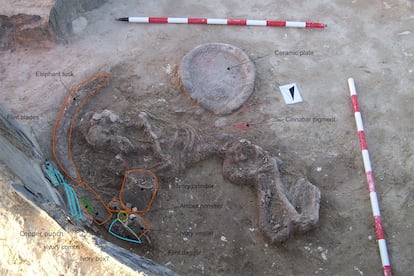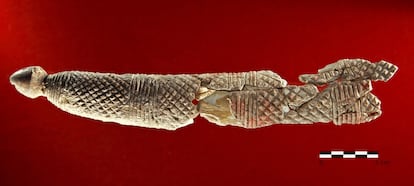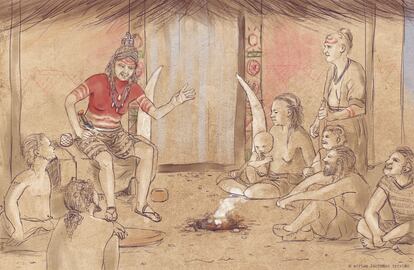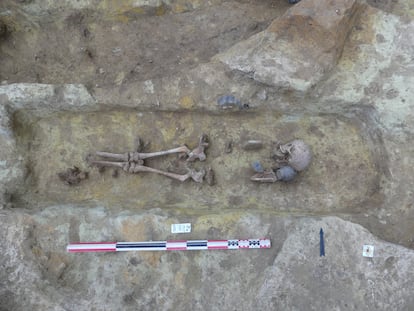The first female leader in the history of the Iberian Peninsula
Archeologists in Spain discover an ornate tomb belonged to a 5,000-year-old woman ‘so prominent that no man ever reached her level,’ prompting reconsideration of the role of gender in the early political life of the peninsula


According to a recent investigation by researchers at the universities of Seville and Vienna, one of the most powerful political figures in ancient Iberia was a woman. Coauthored by Marta Cintas‐Peña, Miriam Luciañez‐Triviño, Raquel Montero Artús, Andrea Bileck, Patricia Bortel, Fabian Kanz, Katharina Rebay‐Salisbury and Leonardo García Sanjuán, the report “invites us to reconsider previous interpretations regarding the political role of women in early complex societies, and the study of human social evolution in general.”
What researchers call “the Mega-site of Valencina de Concepción,” or “the Valencina site” for short, is an enormous archeological complex located a few miles west of Seville, Spain, dating from the Iberian Copper Age (3200 to 2300 BC), and covering roughly 450 hectares, or over 1.7 square miles — an area much larger than other prehistoric sites from the same period. In recent years, researchers have discovered the existence of sophisticated megalithic burial chambers and large trenches dug into the site’s subsoil, as well as evidence of a sophisticated culture of material possession that included luxury objects fabricated from ivory, rock crystal, amber, flint and ostrich eggshell. In addition, archeologists have unearthed abundant human skeletal remains, both male and female. “Valencina offers, therefore, a unique set of data for analyzing the interactions and complexity of these societies, including gender differentiation,” explains García Sanjuán, a professor of Prehistory at the University of Seville.
While burial practices during the Copper Age in Iberia were usually collective, this is not the case with a woman dubbed la Dama del marfil, or the “Ivory Lady.” When this powerful female leader died between the ages of 17 and 25, she was buried alone, with a large selection of important artifacts. A geochemical analysis of her bones revealed surprisingly high levels of mercury, suggesting that the Ivory Lady had experienced, perhaps voluntarily, a significant exposure to cinnabar prior to her death.

The leader was buried with a luxurious funeral trousseau that included a large ceramic dish (on which chemical traces of wine and cannabis were detected), a small copper awl, and multiple flint and ivory objects including an African elephant tusk weighing 1.8 kilograms — an archeological find without precedent in Western Europe
Surprisingly, sometime after her burial, another offering was left at her tomb: a game made from flat slabs of slate, several large ceramic plates, and various objects made from ivory. Among the ivory objects were a beautiful dagger with a rock-crystal blade and an ivory hilt, the handle of which was decorated with mother-of-pearl beads. The researchers describe the Ivory Lady as “the most socially prominent individual of the entire Copper Age period in the Iberian Peninsula.”
The fact that none of the burial sites for children found at Valencina include artifacts suggests that during this period, social status was not assigned by birth or class. Instead, researchers argue, “it is logical to assume that the Ivory Lady did not inherit her social position, but achieved it through personal merit.”

One of the problems specialists currently face in determining the sex of such ancient human remains is that the DNA is often deteriorated. In the initial studies of the Ivory Lady’s skeleton, scientists surmised that the remains belonged to a male. “Sex identification — of crucial importance for anthropological, demographic and sociological analysis — becomes a challenge when the available evidence is thousands of years old,” they explained. Sex determination is hampered by other factors as well, such as the chemical composition of the soil, contamination from atmospheric agents, or site disruptions from scavenging animals or looting. In addition, prehistoric societies often engaged in funerary practices that involved the manipulation, burning, or partial destruction of skeletal remains. These factors often make it difficult to impossible to determine the sex of the deceased by analyzing morphological characteristics (the shape of the pelvis or skull).
In recent years, however, scientists have developed a new technique for determining sex, based on an analysis of peptides (molecules formed by amino acids) in tooth enamel. The method “has yielded surprising results, which will significantly influence future approaches to conducting research in prehistoric archaeology, and specifically in gender archaeology,” report coauthor Marta Cintas-Peña says.

Less than a hundred meters from where archeologists discovered the tomb of the Ivory Lady in 2008, there is another bicameral funerary construction known as the Montelirio tholos, containing the remains of 25 people: three buried in the access corridor, 20 in the main chamber, and two in the small chamber. The tomb was used between the years 2875 and 2635 BC. According to osteological analysis of the remains buried inside, the tomb contained the skeletons of 15 women and five people of undetermined sex. All were adults at the time of their deaths, and most were between the ages of 20 and 35.
Archeologists excavating the tomb unearthed a number of important and valuable artifacts, many made from exotic raw materials such as ivory, rock crystal, gold, amber, mylonite and flint. In addition, some of the women buried in the main chamber were dressed in clothing, including a full-length tunic, made of thousands of perforated beads carved from the shells of large marine mollusks, such as scallops.
Like the Ivory Lady, most of the women buried in the main chamber of the Montelirio tholos had extraordinarily high levels of mercury in their bones, suggesting intense ante mortem exposure to cinnabar. It is possible that these individuals were “religious specialists,” something akin to priestesses.
Experts believe that offerings found in the upper level of the tomb were left when Montelirio was built, between 50 and 100 years after the Ivory Lady was buried. “Those who built Montelirio sought to honor their connection with the Ivory Lady,” the researchers write. “No other tomb, not at Valencina and not at any other site from the Iberian Copper Age, remotely compares in terms of material richness and sophistication.”
“Gender archaeology emerged in the 1960s and early 1970s out of feminist dissatisfaction with androcentric views of prehistory and history, which did not take into account the role of women,” says Cintas-Peña.
The report concludes: “The evidence from Valencina raises more questions than answers about the nature of Late Neolithic and Copper Age societies. Tomb number 10,049 [the tomb of the Lady of Ivory] and the Montelirio tholos suggest that, within the context of the incipient dynamics of social hierarchization that arose between the late 4th millennium and early 3rd millennium in Valencina, women apparently enjoyed a preeminent social position not achieved by men, as shown by their luxurious tombs, which have no comparison in the Iberian Copper Age.”
Sign up for our weekly newsletter to get more English-language news coverage from EL PAÍS USA Edition
Tu suscripción se está usando en otro dispositivo
¿Quieres añadir otro usuario a tu suscripción?
Si continúas leyendo en este dispositivo, no se podrá leer en el otro.
FlechaTu suscripción se está usando en otro dispositivo y solo puedes acceder a EL PAÍS desde un dispositivo a la vez.
Si quieres compartir tu cuenta, cambia tu suscripción a la modalidad Premium, así podrás añadir otro usuario. Cada uno accederá con su propia cuenta de email, lo que os permitirá personalizar vuestra experiencia en EL PAÍS.
¿Tienes una suscripción de empresa? Accede aquí para contratar más cuentas.
En el caso de no saber quién está usando tu cuenta, te recomendamos cambiar tu contraseña aquí.
Si decides continuar compartiendo tu cuenta, este mensaje se mostrará en tu dispositivo y en el de la otra persona que está usando tu cuenta de forma indefinida, afectando a tu experiencia de lectura. Puedes consultar aquí los términos y condiciones de la suscripción digital.
More information
Archived In
Últimas noticias
Most viewed
- Sinaloa Cartel war is taking its toll on Los Chapitos
- Oona Chaplin: ‘I told James Cameron that I was living in a treehouse and starting a permaculture project with a friend’
- Reinhard Genzel, Nobel laureate in physics: ‘One-minute videos will never give you the truth’
- Why the price of coffee has skyrocketed: from Brazilian plantations to specialty coffee houses
- Silver prices are going crazy: This is what’s fueling the rally










































